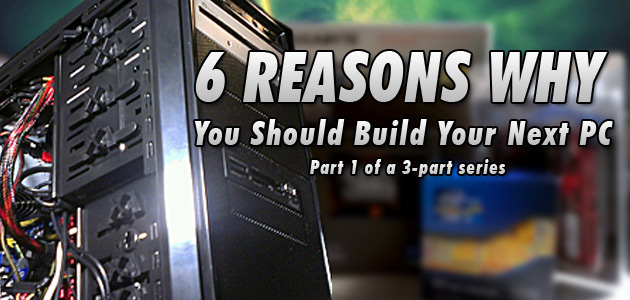 This article is the first part of a three part series on building your own desktop PC. All names and conversations have been re-dramatized to protect the weak and vanquish the evil.
This article is the first part of a three part series on building your own desktop PC. All names and conversations have been re-dramatized to protect the weak and vanquish the evil.
Time to sound old: The first PC I had was a Hewlett Packard 486 DX-2 66MHz with 4MB of RAM and a 420MB hard drive. My parents bought it for me when I was in high school, and it shifted my life into a whole new nerdy direction. I loved that thing. I just remember standing in line at the store, though I was pretty excited, there was a certain amount of guilt because of the sticker price on this thing: $1000. I used the shit out it, for many years, because holy crap, $1000! When it started aging, I installed a 56k modem and an additional 4MB of RAM to speed things up. Eventually, though, it just couldn’t keep, especially when I brought the thing to college. Sitting next to my roommate’s tower desktop HP with an Intel Pentium II 400MHz and 128MB, my little PC that could just wasn’t viable anymore. I remember asking my roommate how much he had paid for his computer. $2000 USD. I couldn’t even remotely afford that back then on my college-y budget. (Hell, I can’t afford that now.) So I gave up dreams of ever getting a new computer.

That’s when Douglas, one of my dorm mates, comes into the picture. Well, I suppose he becomes one of my roommates a year later, during my sophomore year, where when I lived with 6 other dudes in a 3 bedroom apartment. That’s another story for another time.
Well, toward the end of freshman year, our dorm finally got equipped with ethernet connections. I can’t remember the details, but it was going to being quite tough to find an ethernet adapter for my old school computer. That’s when Douglas said, “I can build you a new one.”
“What? You can *build* me one GTFO with your magic talk.”
“No really, I built mine.”
“Whaaaaaaat? You *built* yours? GTFO with your voodoo speech.”
“Dude, no really. I did. I’ve built several before. I can show you how.”
“Wait, really? Where do we get parts? And how much is it gonna cost me?”
“Yes. Fry’s Electronics. And I can build you one for $350.’
“Whahahaaaa, GTFO with your snake oil… can we go today?”
“Yes.”
Sure enough, after a mini-shopping spree at the Fountain Valley Fry’s, and Douglas showing me how to put everything together, I had my very own, new, DIY computer. And it cost me a fraction of the price of my roommate’s, for comparable specs, too. I think it was an AMD K6-2 350MHz, with 64MB of RAM and a RIVA 2 TNT with 16MB of VRAM? I think. Go easy on me folks, it was more than a decade ago. Egads, I’m old.
After that, I became a huge proponent of building your own PC. I’ve never gone back to pre-built, and I don’t think I will ever go back. Laptops, of course, are a different story… I eagerly await the day I can make that happen. Anyway:
6 Reasons You Should Build Your Next PC:
1. It’s cheaper
While the cost margin between a DIY and pre-built system has closed since the late 1990s, it’s still going to save you a little money, especially when you consider the “bang for your buck.” Given a set budget, say $1200, you’re going to be able to build a rig with better specs than the $1200 pre-built. Too, there’s usually a sweet spot around say $350-$400, which is where all the PCs I’ve built for myself have been. I’ve never needed my PCs to be a super bleeding edge, run everything at constant 60fps, blinking LEDs everywhere kinda machine. But, for about $400, I’ve always been able to build a decent all-around machine that can handle most games at a playable framerate, and will run PhotoShop and Premiere with reasonable speed. After all, if you need that little performance boost, there’s always overclocking.
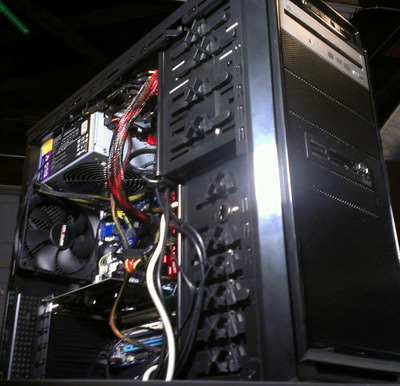
2. You can build a system specific to your needs
By building your own rig, you are building a personalized tool to meet your specific needs. An amazing gaming PC isn’t necessarily going to be the best editing PC, and vice versa. You could build a machine that is all-around badass at EVERYTHING, but that would cost a pretty penny. If you’re trying to cut costs (who isn’t, really?) by going DIY, you can put together a rig that buff certain components, while scaling back on others. Say you wanted to do mostly just email and websurfing, possibly some light MMO type gaming, editing for a family video or two, and you were on a budget. I’d advocate building rig with a low-mid level CPU, like the Intel Core i3s or the AMD Athlon IIs, but give you a nice 8GB of RAM, and a descrete video card in the $50 range. Better yet, one of the AMD A-Series APUs. So much budget goodness. If you were bulding an editing computer, we’d go with Intel all the way, max out your RAM, and Hard Drive space, and buy a video card with enough beef to run the Mercury Playback Engine in Premiere. Different strokes for different computer folks. I mean, you could go through a giant list of pre-builts to find one that has the specs yout want, but that sounds tedious.
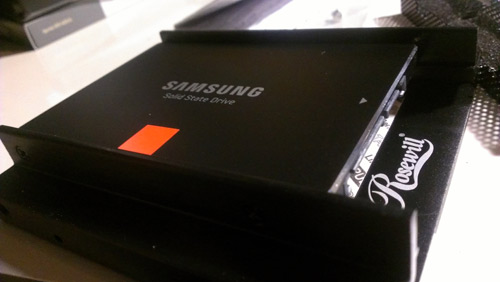
3. You know exactly what’s in your system
One of the things that has always perturbed me was the shitty components I would see inside the case when repairing a friend’s pre-built computer. Sure, the computer sounds good on paper, and the CPU is always going to be what it says on the box, but what about the other components? The specs say it comes with 8GB of RAM, but who made the RAM chips? Who made the motherboard? Is it a reputable brand, or did the bulk contract go to the lowest bidder? It more than likely went to the lowest bidder, and you are getting the cheapest possible components so the computer manufacturer can make more money. When you buy individual components on your own, you can say with a greater deal of accuracy that you’re getting quality products. And if you buy from a reputable retailer, each component will have its own warranty in case something goes awry. You usually won’t run into the problem of cheap components with higher-end system builders, like Alienware, Falcon, or CyberPower, but you pay a premium for those. I’d be wary of any brands you can get in a big box store.
4. Easy repair/upgrades
On the component going awry note: DIY PCs are extremely modular, so if a part dies on you, you can easily swap it out with a new one. Yes, you can do this with possibly the hard drive, expansion cards, RAM in a pre-built. If your motherboard or CPU/heatsink go to shit, you might be SOL. Same goes for your power supply. Reason being, that sometimes big box pre-built systems have proprietary components that can only be serviced by certified techs for that brand. Basically, only certain techs have access to direct replacement parts for that computer, and if it breaks you have to either call in a repair tech to come take a look, or ship the entire thing it off to a warranty center. This may no longer be the case now, but it sure was back when I was doing desktop support. With a DIY system, you have the option of walking into a brick and mortar store, buying a new component, and having your system back up in an hour. Most of this is true with upgrades as well, you don’t know what you’re getting motherboard-wise with a pre-built, so upgrading something as simple as RAM can be a chore because you don’t know if it’s going to be compatible.
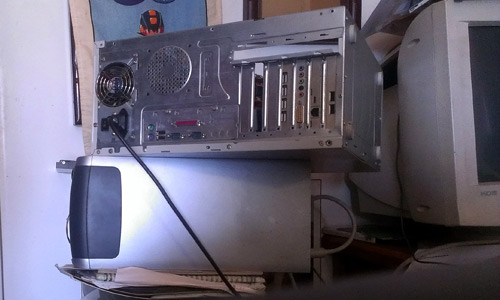
5. No bloatware
What is bloatware? Bloatware is basically all that crappy software that comes on a pre-built that isn’t part of the OS (Operating System), usually Windows in the case of a PC. Basically, anything that says “trial” or any program on your desktop that has the same branding as the computer itself, is bloatware. Anti-virus trials, camera utilities, trial games, (insert computer brand here) network utility, is all bloatware. For the most part the software is crap and serves solely to clutter your system startup by adding “agents” and “startup helpers” that run in the background and slow down your computer. Delete it all. As a matter of fact, for a while, I’ve advocated that when people get a new PC, they should just wipe the damn hard drive and install a fresh copy of the OS. With a self-built rig, this isn’t even a concern.
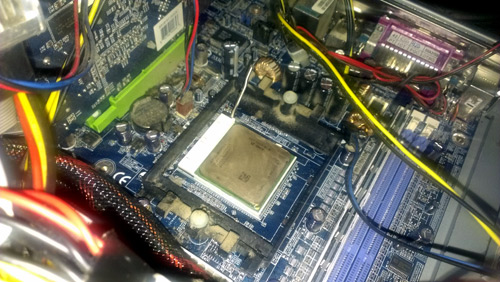
6. It’s easier than you think
Seriously. I was an 18-year old with an attention deficit, and I built my own PC. I’m sure kids younger are accomplishing the same thing. Truthfully, it’s kind of hard to break a computer, like really break a computer to the point where it’s unsalvageable. It takes effort to do that. Effort, and power tools. Or water. Or wool socks. Look, there are certain precautions you take when you build a PC, and I’ll go over them in a future article. But take my word for it: It’s not rocket science, at least not at the base level. I’m not talking about airflow, or water cooling, or phase change, or rheostats, or lapping, or aluminum vs. copper, or multipliers, or front side bus frequency… that might be kinda rocket science-y. But building a regular home PC is not bad at all. The components are made ot be modular, so it really is slap it all together, and go.
Well that’s it. Hopefully, I’ve convinced you that DIY computing is something you might want to try. It really just makes things easier, and puts everything in your hands. Questions, quandaries, queries? Let me know.
Stay tuned for the next entry in this series, where I’ll go over the DIY PC build shopping list.
